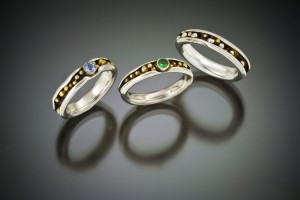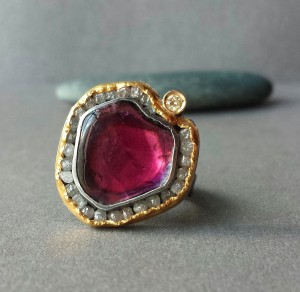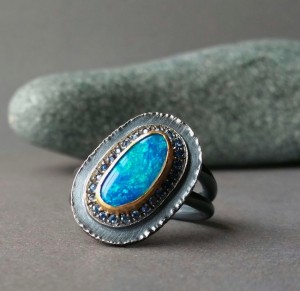
“River Pebbles.” Sterling and 18k gold, with blue sapphire and Tsavorite garnet. Photo courtesy Deb Carus, Elentari Handverk.
If you attend art and craft shows—and if you make artisan jewelry, you probably have—you know they can be a lot of fun. At a good show, there are lot of interesting pieces—not only jewelry, but sculpture, painting, fibers, woodwork. There’s lots of potential for inspiration.
But for a retail show to be successful for someone holding down a booth at one, the artist has to be willing to engage potential customers. Many artists enjoy the chance to “chat up” their work to potential buyers. They are, after all, enthusiastic about the pieces they make. (Aren’t you?)
However, you may be one of many artists who would rather bungee jump off the Golden Gate Bridge than “sell” to a bunch of strangers. You probably hate to be “sold to” so it’s hard for you to be on the selling end. That can make working a retail show uncomfortable if not painful.
But the payoff to presenting your work at a retail craft show can be so great that it’s

Ring set with tourmaline slice, raw diamonds, and one brilliant cut diamond. Photo courtesy Janice Grzyb.
worth finding a way past the pain. Getting a boost from meeting the people who love your work enough to buy it. Getting feedback about what works, what’s appealing and what’s not. So consider this a treasure hunt—you’re trying to find new friends and customers. Keep these pointers in mind:
- Be approachable. Don’t hide in the corner of your booth. Stay alert, smile and make eye contact. Show people that you’re excited about your work.
- Don’t pounce. Learn to read customers so you’ll know when to settle for a simple “Hi,” and when to offer to show them something. “You can usually tell in the first 10 to 15 seconds if they’re going to want to talk to you or try something,” says Portland jewelry artist Deb Carus. Give people time to look and see if something snags their attention.
- Group similar pieces together–pieces with stones, and those without, copper work in one place and sterling in another. When someone focuses on a particular case, you’ll have an idea of how to open a conversation.
- Be upbeat, polite and professional. Don’t complain about the show, the organizers, the weather or the other customers.
- People buy when your product matches their needs and desires. To help them see the connection, you need to know a bit about the customer or gift recipient—interests that might be echoed in your work, how active their lifestyle is, what other types of art and craft they enjoy. (This is called profiling.) If you can, match something in your line to what they’ve told you. Eavesdrop. Listen to what they say to the friends they’re with. Start a conversation yourself—what brings them to the fair in the first place?
- Talk about your work. What stone or found object is in the piece, why did you choose it? What techniques did you use? What inspired you? People usually love to hear the story behind a piece. It just may prove to be the way that they connect to a piece, making them want to take it home.
- Some shows allow you to work in your booth. This keeps your hands busy, attracts attention and questions, and reinforces the fact that your work is hand made. However, only bring work that will not demand your attention at the expense of talking to people. Think of the tasks you can readily set down to engage with customers, things such as putting earwires on earrings, hand-sanding components, or sketching out new designs are the best.
- Never ask a customer’s budget. Most people will spend more on an item than you think they will—especially at an art fair where they are looking for something unique and hand made. If they do express a price concern, you can show them something “more affordable,” or “at more comfortable price.” Offer earrings instead of a neckpiece or brooch. Offer a different stone or metal. “Never say the word ‘cheap’,” says New York jewelry artist Janice Grzyb (Grib), marketing instructor at the community center 92Y, “or this is cheaper than that.”

